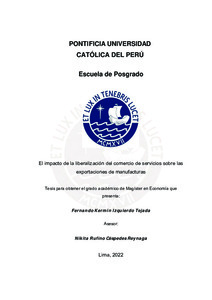El impacto de la liberalización del comercio de servicios sobre las exportaciones de manufacturas
Abstract
El objetivo principal de esta tesis es medir el impacto de una eventual
liberalización comercial en el comercio de servicios sobre las exportaciones de
manufacturas, al considerar los servicios como insumos productivos necesarios
en la producción manufacturera. Para lograr el objetivo principal es necesario
primero identificar tres objetivos secundarios. Primero, la implementación de
tarifas equivalentes asignando valores cuantitativos a las barreras comerciales
cualitativas que caracterizan al comercio de servicios. Segundo, evaluar el
impacto de la política comercial según la intensidad en el uso de servicios
como insumos en el sector manufacturero para tres casos específicos:
Australia, Perú y México. Tercero, identificar cuáles son los servicios
domésticos más afectados. A través de la implementación del modelo de
equilibrio general computable del GTAP se logra simular un escenario contra-
factual en donde se aplica la política comercial de liberalización del sector
servicios de cada uno de los países seleccionados. Entre los principales
resultados se observa el incremento de importaciones de servicios, seguido de
un incremento en las compras de servicios extranjeros por parte del sector de
manufacturas, debido a una reducción de costos (servicios importados), lo cual
permite un aumento de las exportaciones de manufacturas. Si bien existe un
efecto de sustitución entre el uso de servicios domésticos por los extranjeros,
las ganancias producto del incremento de exportaciones manufactureras
termina siendo mayor. The main objective of this work is to measure the impact of a possible trade
liberalization in trade in services on exports of manufactures, considering
services as productive inputs necessary in manufacturing production. To
achieve the main objective it will be necessary to first identify two secondary
objectives. First, the implementation of equivalent tariffs assigning quantitative
values to the qualitative trade barriers that characterize trade in services.
Second, evaluate the impact of trade policy according to the intensity in the use
of services as inputs on manufacturing sector for three specific cases: Australia,
Peru, and Mexico. Third, identify which are the most affected domestic services.
Through the implementation of the GTAP ́s Computable General Equilibrium
Model, it is possible to simulate a counterfactual scenario in which the trade
policy of liberalization of the services sector of each of the selected countries is
applied. Among the main results is the increase in imports of services, followed
by an increase in purchases of foreign services by the manufacturing sector,
and finally by increasing exports of manufactures. Although there is a
substitution effect between domestic services by foreigners services, the gains
resulting from the increase in manufacturing exports ends up being higher.
Temas
Manufacturas--Perú
Exportación--Perú
Barreras comerciales no arancelarias--Perú
Exportación--Perú
Barreras comerciales no arancelarias--Perú
Para optar el título de
Maestro en Economía
Collections
The following license files are associated with this item:






